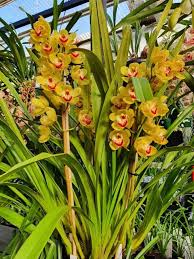# Factors Affecting the Flowering Time of Sato Cymbidium Orchids

Sato Cymbidium orchids, renowned for their striking beauty and resilience, are a favorite among orchid enthusiasts and gardeners alike. While they are celebrated for their vibrant flowers and unique growth patterns, understanding the factors that influence their flowering time is essential for anyone looking to cultivate these exquisite plants successfully. In this article, we will explore various elements that impact the flowering time of Sato Cymbidium orchids, ranging from environmental conditions to cultivation techniques and genetic factors.
## 1. Environmental Conditions
### a. Light
Light is one of the most critical factors influencing the flowering of Sato Cymbidium orchids. These orchids thrive in bright, indirect light, which mimics their natural habitat. Insufficient light can lead to delayed flowering, while excessive direct sunlight can scorch the leaves and hinder flower development. The ideal light intensity for Sato Cymbidium orchids is around 1,500 to 2,500 foot-candles.
To promote timely flowering, gardeners should ensure that their orchids receive adequate light throughout the day. This can be achieved by placing them near east or west-facing windows, where they can receive the morning or late afternoon sun without being exposed to the harsh midday rays. For those growing Sato Cymbidium orchids indoors, using grow lights can also help provide the necessary light levels, especially during the shorter days of winter.
### b. Temperature
Temperature plays a significant role in the growth and flowering of Sato Cymbidium orchids. These orchids prefer a temperature range of 65°F to 75°F (18°C to 24°C) during the day and slightly cooler temperatures at night, ideally between 50°F to 60°F (10°C to 15°C). This fluctuation in temperature mimics the natural day-night cycle, triggering the orchids to bloom.
When temperatures are too high or too low, the flowering process can be delayed. For example, if daytime temperatures consistently exceed 80°F (27°C) or drop below 50°F (10°C), the plants may become stressed and postpone flowering. Gardeners should strive to maintain optimal temperature conditions, particularly during the months leading up to the expected bloom time.
### c. Humidity
Humidity is another crucial factor that affects the flowering of Sato Cymbidium orchids. These orchids thrive in environments with humidity levels ranging from 50% to 70%. Adequate humidity helps the plants absorb moisture and nutrients, which are vital for flower development.
Low humidity levels can lead to desiccation and stress in Sato Cymbidium orchids, causing them to delay blooming. To maintain optimal humidity levels, gardeners can use humidifiers, mist the plants regularly, or place trays filled with water and pebbles near the orchids to increase moisture in the air. Conversely, excessive humidity can lead to fungal issues, so it’s essential to strike a balance.
## 2. Watering Practices
### a. Water Quality
The quality of water used for irrigation significantly affects the health and flowering of Sato Cymbidium orchids. These orchids are sensitive to chlorine and other chemicals commonly found in tap water. Using distilled or rainwater is often recommended to avoid potential harm from chemicals.
Additionally, the pH level of the water should be monitored. Sato Cymbidium orchids prefer slightly acidic conditions, with a pH range of 5.5 to 6.5. If the water’s pH is too high, it can inhibit nutrient absorption, leading to poor growth and delayed flowering.
### b. Watering Frequency
The frequency of watering is another critical factor that influences flowering time. Sato Cymbidium orchids prefer to dry out slightly between waterings. Overwatering can lead to root rot, while underwatering can cause the plants to become stressed and delay blooming.
A general rule of thumb is to water the orchids thoroughly when the top inch of the potting medium feels dry to the touch. The use of well-draining potting media, such as a mix of bark and perlite, can help ensure proper drainage and aeration, further promoting healthy root development and timely flowering.
## 3. Fertilization
### a. Nutrient Composition
The type and composition of fertilizers used can significantly impact the flowering of Sato Cymbidium orchids. A balanced fertilizer with a ratio of 30-10-10 (N-P-K) is often recommended during the active growth period. The higher nitrogen content promotes vegetative growth, while potassium aids in flower development.
As the orchids approach their blooming phase, switching to a fertilizer with a higher phosphorus content can further stimulate flower formation. Phosphorus is essential for flower bud development and overall bloom quality. Gardeners should follow the manufacturer’s guidelines for application rates and frequency to avoid over-fertilization, which can lead to nutrient imbalances and hinder flowering.
### b. Timing of Fertilization
The timing of fertilization is crucial for promoting timely flowering in Sato Cymbidium orchids. Fertilizers should be applied during the active growing season, typically in spring and summer. As the fall approaches and the orchids enter dormancy, reducing or stopping fertilization helps prepare the plants for their natural resting period.
By aligning fertilization practices with the growth cycle of the orchids, gardeners can enhance the likelihood of successful blooming.
## 4. Plant Care Practices
### a. Repotting
Repotting Sato Cymbidium orchids is a vital aspect of their care and can influence flowering time. Orchids should be repotted every 1 to 2 years or when the potting medium breaks down and loses its effectiveness. Repotting helps refresh the growing medium, provides adequate drainage, and encourages root growth.
However, it’s essential to repot at the right time. Repotting during the blooming phase can cause stress and lead to a delay in flowering. The ideal time to repot is after the blooming period, allowing the plant to focus on establishing its roots before entering the next growth cycle.
### b. Pruning and Deadheading
Pruning and deadheading are important practices for maintaining the health and aesthetics of Sato Cymbidium orchids. Deadheading, or removing spent blooms, helps redirect the plant’s energy towards new growth and flowering. Regular pruning of old, dead, or damaged leaves can also improve air circulation and overall plant health.
By promoting a healthy growing environment through these practices, gardeners can create optimal conditions for blooming.
## 5. Genetic Factors
### a. Hybrid Variability
Sato Cymbidium orchids encompass a wide range of hybrids, each with unique genetic traits that can influence flowering time. Some hybrids may have shorter or longer bloom cycles, depending on their parentage. Understanding the specific characteristics of the hybrid being cultivated can provide insights into its expected flowering time.
### b. Dormancy Period
Different Sato Cymbidium hybrids may also exhibit varying dormancy periods. Some hybrids require longer periods of rest before they are ready to bloom, while others may flower more readily with less dormancy. Gardeners should familiarize themselves with the specific requirements of their orchid hybrids to optimize care and promote timely flowering.
## 6. Conclusion
The flowering time of Sato Cymbidium orchids is influenced by a complex interplay of environmental conditions, care practices, and genetic factors. By understanding and optimizing these elements, gardeners can enhance the chances of achieving vibrant blooms on their orchids. Proper light exposure, temperature management, humidity control, and appropriate watering and fertilization practices all contribute to the health and blooming potential of Sato Cymbidium orchids.
In the next section, we will explore practical tips for fostering an ideal environment for flowering and address common challenges faced by growers. Through careful observation and attention to detail, orchid enthusiasts can enjoy the stunning beauty of Sato Cymbidium orchids, celebrating their blooms as a testament to the dedication and knowledge invested in their care.
# Factors Affecting the Flowering Time of Sato Cymbidium Orchids (Part 2)
In the first part of this article, we examined various critical factors influencing the flowering time of Sato Cymbidium orchids, including environmental conditions, watering practices, fertilization, plant care practices, and genetic factors. In this second part, we will delve deeper into these elements, providing practical insights and strategies to optimize blooming times. By understanding these factors thoroughly, orchid enthusiasts can ensure that their Sato Cymbidium orchids bloom beautifully and on schedule.
## 1. Environmental Conditions (Continued)
### a. Light Quality
While we previously discussed light intensity, it is equally important to consider the quality of light. Different light spectrums can affect the growth and flowering of Sato Cymbidium orchids. Natural sunlight is ideal, but for indoor growers, artificial grow lights can help mimic natural conditions.
– **Full Spectrum Lights:** These lights emit a range of wavelengths, closely resembling natural sunlight. They can be particularly beneficial during the winter months or in regions with limited sunlight.
– **LED Grow Lights:** Energy-efficient and long-lasting, LED lights can provide the appropriate light spectrum for optimal growth. When using LED lights, aim for a combination of red and blue wavelengths, as these have been shown to enhance flowering.
By ensuring that Sato Cymbidium orchids receive high-quality light, gardeners can encourage robust growth and timely blooming.
### b. Seasonal Changes
Understanding the seasonal changes in the environment can also help in managing flowering time. Orchids naturally respond to the seasons, with longer daylight hours in spring prompting growth and blooming.
– **Photoperiod:** Many orchids, including Sato Cymbidium, require specific light durations to trigger blooming. Keeping track of day length and adjusting light exposure can aid in promoting timely flowering.
– **Temperature Variations:** Seasonal shifts often bring temperature changes. Utilizing methods to maintain stable temperatures, such as using thermal curtains or heating mats, can prevent stress on the orchids during extreme temperature fluctuations.
By adapting care routines to seasonal changes, gardeners can enhance the likelihood of successful blooming.
## 2. Watering Practices (Continued)
### a. Watering Techniques
The technique used for watering can influence the health and flowering of Sato Cymbidium orchids.
– **Soaking Method:** Soaking the potting medium in water for a brief period can ensure even moisture distribution and encourage robust root growth. After soaking, allow the pot to drain thoroughly to prevent waterlogging.
– **Bottom Watering:** Placing pots in a tray of water allows the orchids to absorb moisture from the bottom. This method is particularly useful for plants that prefer consistent moisture but are susceptible to root rot.
Understanding and implementing effective watering techniques can greatly enhance the overall health and flowering potential of Sato Cymbidium orchids.
### b. Water Temperature
The temperature of the water used for irrigation is often overlooked but can significantly impact plant health.
– **Room Temperature Water:** Water at room temperature is preferable, as cold water can shock the roots and hinder nutrient absorption.
– **Temperature Variations:** Additionally, the temperature of the water can be adjusted according to the season. During warmer months, slightly cooler water may be beneficial, while warmer water can promote growth during cooler months.
By considering the water temperature, gardeners can provide a more conducive environment for blooming.
## 3. Fertilization (Continued)
### a. Organic vs. Synthetic Fertilizers
The choice between organic and synthetic fertilizers can impact the health of Sato Cymbidium orchids and their flowering potential.
– **Organic Fertilizers:** These slow-release fertilizers improve soil structure and promote microbial activity, enhancing nutrient availability. Organic fertilizers, such as compost or worm castings, can lead to healthier root systems and more vibrant blooms.
– **Synthetic Fertilizers:** While these can provide immediate nutrients, over-reliance on synthetic fertilizers can lead to salt buildup in the potting medium, potentially damaging the roots. It’s essential to flush the pots with water occasionally to prevent this buildup.
Choosing the right type of fertilizer based on the specific needs of the orchids can promote healthier growth and timely flowering.
### b. Foliar Feeding
Foliar feeding is a technique that involves applying liquid fertilizers directly to the leaves. This method can be particularly effective for providing essential nutrients quickly.
– **Application Timing:** The best time to foliar feed is early in the morning or late afternoon when the leaves are not exposed to direct sunlight.
– **Nutrient Mixtures:** A balanced foliar fertilizer can help boost the plants during the critical periods leading up to flowering, ensuring they have the nutrients needed for robust blooms.
Incorporating foliar feeding into the care routine can enhance the overall health and flowering potential of Sato Cymbidium orchids.
## 4. Plant Care Practices (Continued)
### a. Pest and Disease Management
Healthy plants are more likely to bloom on schedule. Pests and diseases can stress Sato Cymbidium orchids, leading to delayed flowering.
– **Regular Inspections:** Gardeners should regularly inspect their orchids for signs of pests such as aphids, spider mites, and mealybugs.
– **Preventative Treatments:** Utilizing organic pesticides and fungicides can help manage potential infestations before they become problematic. Neem oil and insecticidal soap are effective for controlling pests without harming the plants.
By maintaining vigilance regarding pests and diseases, gardeners can keep their orchids healthy and encourage timely flowering.
### b. Environmental Stress Management
Stress can significantly affect the blooming of Sato Cymbidium orchids.
– **Adaptation to Changes:** Rapid changes in environment, such as moving plants from indoors to outdoors, can shock the orchids and delay flowering. It’s essential to acclimate them gradually to new conditions.
– **Avoid Overcrowding:** Ensuring that orchids have enough space to grow without competition from other plants can help reduce stress and promote healthy blooming.
By managing environmental stressors, gardeners can provide a more stable growing environment conducive to flowering.
## 5. Genetic Factors (Continued)
### a. Selection of Hybrid Varieties
The choice of hybrid varieties can impact flowering time. Some Sato Cymbidium hybrids are specifically bred for early or late blooming, making it essential to select the right variety based on the gardener’s preferences.
– **Early-Blooming Hybrids:** For those who desire blooms early in the season, selecting hybrids known for early flowering can provide satisfaction.
– **Longer Blooming Hybrids:** Conversely, some hybrids may take longer to bloom but produce larger and more vibrant flowers. Understanding the genetic traits of different hybrids can help gardeners make informed decisions.
### b. Research and Development
As breeding techniques continue to evolve, new hybrids are being developed that may have unique flowering characteristics.
– **Staying Informed:** Keeping up with the latest research and developments in orchid breeding can provide insights into new varieties that may suit a gardener’s growing conditions and flowering preferences.
By selecting the appropriate hybrids and staying informed about breeding advancements, gardeners can optimize their chances of achieving vibrant blooms on schedule.
## 6. Conclusion
The flowering time of Sato Cymbidium orchids is influenced by a complex interplay of environmental conditions, care practices, fertilization, and genetic factors. By understanding and optimizing these elements, gardeners can enhance their chances of achieving beautiful blooms.
In summary, the following key strategies can promote timely flowering:
– Ensure adequate light quality and intensity.
– Maintain optimal temperature and humidity levels.
– Use appropriate watering techniques and water quality.
– Choose the right fertilizers and application methods.
– Implement effective pest and disease management practices.
– Select hybrid varieties based on desired flowering characteristics.
With careful attention to these factors, orchid enthusiasts can enjoy the stunning beauty of Sato Cymbidium orchids, celebrating their blooms as a testament to the dedication and knowledge invested in their care. By fostering an environment that meets the needs of these remarkable plants, gardeners can unlock the full potential of their Sato Cymbidium orchids, leading to a flourishing display of vibrant flowers.

